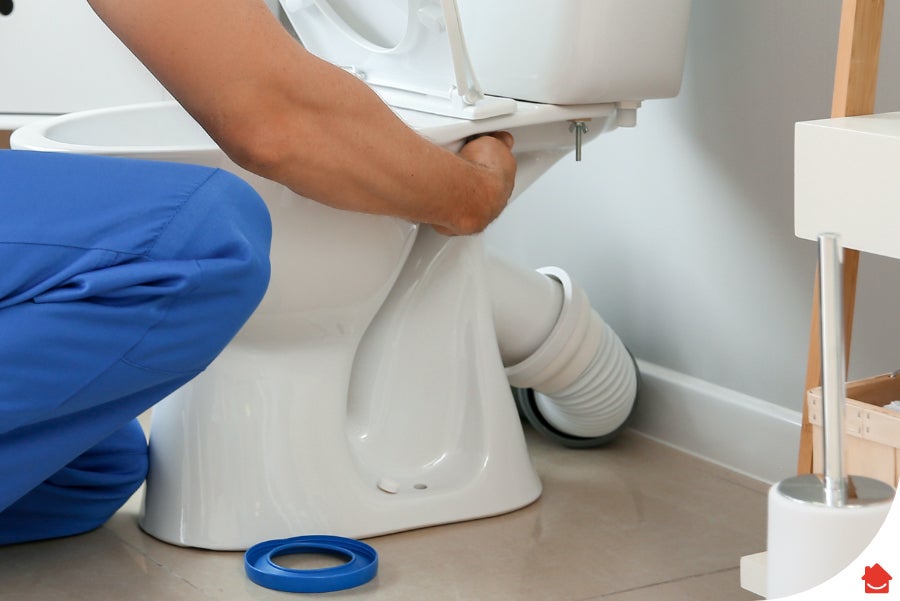Plumbing advice
How to plumb a toilet waste pipe
13 Aug 2021 • 4 minutes


Congratulations! You’ve reached the most un-glamorous page on the entire internet! Chances are you’re here out of necessity and you need a step-by-step guide to fitting a toilet pan connector.
You’re in the right place, so read on and we’ll show you how to fit and plumb a toilet waste pipe.
You might be a new homeowner replacing an old and worn out toilet pan connector or installing a new one in a completely new place as part of a bathroom renovation or new en-suite installation. Either way, you’ll need to access the part that meets the sewer drains through a hole in the wall or the floor. You’ll also have some joining work to do.
If your toilet waste pipe is fine but you need help with installing a toilet or fitting a toilet seat, take a look at our detailed guides to get the assistance you need.
Your toilet pan connector’s main function is to carry out the flush water into the drain. So it’s a crucial part of your home’s plumbing.
Installing a toilet waste pipe can take a while, and requires intermediate DIY/plumbing skills. If this isn’t part of your usual skillset, we recommend you hire a plumber to take on this rather involved project.
If you’re ready to roll up your sleeves and do this, let’s go!
If you have a working waste pipe that you’re connecting a new toilet to, it’s definitely recommended to cover and seal it using a bag or cloth while it’s not connected to the toilet, to prevent potentially harmful (and odorous) gases entering your bathroom from the sewers below.
We also assume your mains water is switched off if you have an unconnected waste pipe.
The toilet flange attaches your toilet to the waste pipe and helps to prevent the toilet from rocking, keeping it secure.
If you’re replacing an old toilet waste pipe, you’ll need to make sure the pipeline clears the hole in the flooring or the wall and connects securely to the sewer drains. If you are moving the position of the toilet in your bathroom, or creating an entirely new en-suite, for example, you’ll need to carve out the hole yourself using a drill with a spade bit and then a jigsaw, in order to fit the toilet flange piece to the soil pipe.
Once the toilet is connected to the soil pipe, you then need to fix it to the floor using screws.
Some toilets have 2 or 4 screws that go into the floor. Some toilets have L shape brackets which are fixed to the floor and are hidden inside the toilet base. Screws are then fixed into these brackets from the outside.
You’ll now need to connect a new pan connector of suitable length.
Use ABS glue to connect the two pieces, holding it under pressure in the same position for 30 to 35 seconds. Be careful – any time before 30 seconds and the pipes can easily slip as the glue is still not sticky enough. You can’t be too careful here as you don’t ever want that toilet waste water leaking inside your house.
This is called your ‘toilet rough-in’ distance, meaning the distance from the wall to the centre of the waste pipe. Most toilets have a rough-in of 12 inches, although older homes can have 10 or 14 inches.
A typical toilet waste pipe is 100mm/4 inches in diameter.
When a house is being newly built or completely renovated it’s relatively easy to route this large pipe from the toilets to the drain. If you’re routing a pipe to a new bathroom and all the internal walls are already up, it’s more difficult. As a workaround, some people fit a macerator here so they can fit a smaller pipe.
Yes, but the sink must empty into the toilet drain. Toilets have the largest drainpipe, so plumbers empty the bathroom sink drain, which is smaller in diameter, into the toilet drain line. They install a common vent that allows water and waste to drain without forming an airlock.
If you've managed to plumb your toilet waste pipe yourself, we salute you!
Even if you have a decent level of plumbing knowledge, it's always good to have access to an expert plumber you can trust. That's where Ding comes in. With Ding, a home repair membership, you can access our qualified plumbers for £5 a month.
Our help & advice articles cover Plumbing, Home heating, Electrical, Energy-saving and Home maintenance.